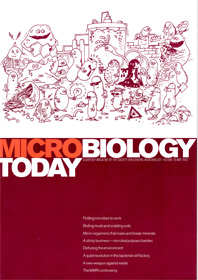Microbes at Work
01 May 2002 publication
The lead articles of the May 2002 issue of Microbiology Today are on putting microbes to work; boiling muds and scalding soils; micro-organisms that make and break minerals; a sticky business - microbial polysaccharides; defusing the environment; a quiet revolution in the bacterial cell factory; a new weapon against waste; and the MMR controversy.
Putting microbes to work (p. 63)
Microbial activities can be harnessed for our benefit in a huge variety of ways. Kristien Mortelmans provides an overview which serves as an introduction to the theme of this issue of Microbiology Today.
Boiling muds and scalding soils: new species and enzymes for the future (p. 64)
Extremophiles have adapted to live in harsh environments, such as hot springs, polar zones and salt lakes. David Lloyd describes some of these fascinating microbes and the metabolism which allows them to survive, before exploring the potential applications of the enzymes they produce.
Bioremediation of metals; the application of micro-organisms that make and break minerals (p. 67)
Environmental pollution by metals is a serious problem. Jonathan Lloyd describes some ways in which microbes can be used in the clean-up process.
A sticky business. Microbial polysaccharides: current products and future trends (p. 70)
The ingredients list of many foodstuffs includes microbial polysaccharides. Ian Sutherland reveals the potential and applications of these polymers.
Defusing the environment (p. 72)
Environmental contamination by explosives presents a serious problem. Bacteria and plants may provide the solution, as Elaine Boyd and Neil Bruce describe.
A quiet revolution in the bacterial cell factory (p. 76)
David Summers describes the development of a novel Quiescent Cell Expression System which has commerical protential for the production of proteins.
Bacteria, their precious metal armour, and a new weapon against waste (p. 80)
Sulfate-reducing bacteria have exciting applications in the biorecovery of precious metals and in the bioremediation of toxic wastes.
Going Public (p. 90)
Emma Sheppard reports on her final year undergraduate project involving teaching microbiology to 10 year olds. Helen Smalley desribes a practical microbiology course for post-16 students in Merseyside.
Gradline (p. 92)
The finals of the Promega Young Life Scientists of the Year 2002 took place at the spring meeting of the Genetics Society in York on 21 March. Tracey Duncombe chats to Rut Carballido-López about winning the prize.
Schoolzone (p. 93)
Helen Nankervis explains the new option at GCSE level - vocational GCSEs.
Comment - MMR Vaccine (p. 116)
There is a serious decline in the vaccination of young children against measles, mumps and rubella due to concerns about safety and possible links between the triple vaccine and bowel disease and autism. Drs Afzal and Minor explore the scientific background to this important issue.

